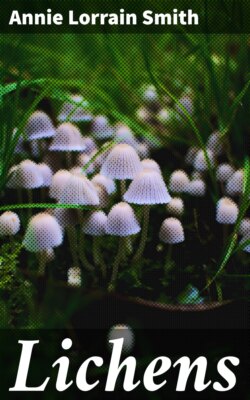Читать книгу Lichens - Annie Lorrain Smith - Страница 51
На сайте Литреса книга снята с продажи.
B. Types of Thallus
ОглавлениеThree factors, according to Reinke[312], have been of influence in determining the thalline development. The first, and most important, is the necessity to provide for the work of photosynthesis on the part of the alga. There is also the building up of a tissue that should serve as a storage of reserve material, essential in a plant the existence of which is prolonged far beyond the natural duration of either of the component organisms; and, finally, there is the need of protecting the long-lived plant as a whole though more particularly the alga.
Wallroth was the first to make a comparative study of the different lichen thalli. He distinguished those lichens in which the green cells and the colourless filaments are interspersed equally through the entire thallus as “homoiomerous” (Fig. 2), and those in which there are distinct layers of cortex, gonidia, and medulla, as “heteromerous” (Fig. 1), terms which, though now considered of less importance in classification, still persist and are of service in describing the position of the alga with regard to the general structure. A less evident definition of the different types of thallus has been proposed by Zukal[313] who divides them into “endogenous” and “exogenous.”
a. Endogenous Thallus. The term has been applied to a comparatively small number of homoiomerous lichens in which the alga predominates in the development, and determines the form of the thallus. These algae, members of the Myxophyceae, are extremely gelatinous, and the hyphae grow alongside or within the gelatinous sheath. In the simpler forms the vegetative structure is of the most primitive type: the alga retains its original character almost unchanged, and the ascomycetous fungus grows along with and beside it (Fig. 4). Such are the minutely tufted thalli of Thermutis and Spilonema and the longer strands of Ephebe, in which the associated Scytonema or Stigonema, filamentous blue-green algae, though excited to excessive growth, scarcely lose their normal appearance, making it difficult at times to recognize the lichenoid character unless the fruits also are present.
Equally primitive in most cases is the structure of the thallus associated with Gloeocapsa. The resulting lichens, Pyrenopsis, Psorotichia, etc. are simply gelatinous crusts of the alga with a more or less scanty intermingling of fungal hyphae.
In the Collemaceae, the gonidial cells of which are species of Nostoc (Fig. 2), there appears a more developed thallus; but in general, symbiosis in Collema has wrought the minimum of change in the habit of the alga, hence the indecision of the earlier botanists as to the identification and classification of Nostoc and Collema. Though in many of the species of the genus Collema no definite tissue is formed, yet, under the influence of symbiosis, the plants become moulded into variously shaped lobes which are specifically constant. In some species there is an advance towards more elaboration of form in the protective tissues of the apothecia, a layer of thin-walled plectenchyma being occasionally formed beneath or around the fruit as in Collema granuliferum.
In all these lichens, it is only the thallus that can be considered as primitive: the fruit is a more or less open apothecium—more rarely a perithecium—with a fully developed hymenium. Frequently it is provided with a protective thalline margin.
b. Exogenous Thallus. In this group, composed almost exclusively of heteromerous lichens, Zukal includes all those in which the fungus takes the lead in thalline development. He counts as such Leptogium, a genus closely allied to Collema but with more membranous lobes, in which the short terminal cells of the hyphae have united to form a continuous cortex. A higher development, therefore, becomes at once apparent, though in some genera, as in Coenogonium, the alga still predominates, while the simplest forms may be merely a scanty weft of filaments associated with groups of algal cells. Such a thallus is characteristic of the Ectolechiaceae, and some Gyalectaceae, etc., which have, indeed, been described by Zahlbruckner[314] as homoiomerous though their gonidia belong to the non-gelatinous Chlorophyceae.
Heteromerous lichens have been arranged by Hue[315] according to their general structure in three great series:
1. Stratosae. Crustaceous, squamulose and foliose lichens with a dorsiventral thallus.
2. Radiatae. Fruticose, shrubby or filamentous lichens with a strap-shaped or cylindrical thallus of radiate structure.
3. Stratosae-Radiatae. Primary dorsiventral thallus, either crustaceous or squamulose, with a secondary upright thallus of radiate structure called the podetium (Cladoniaceae).
